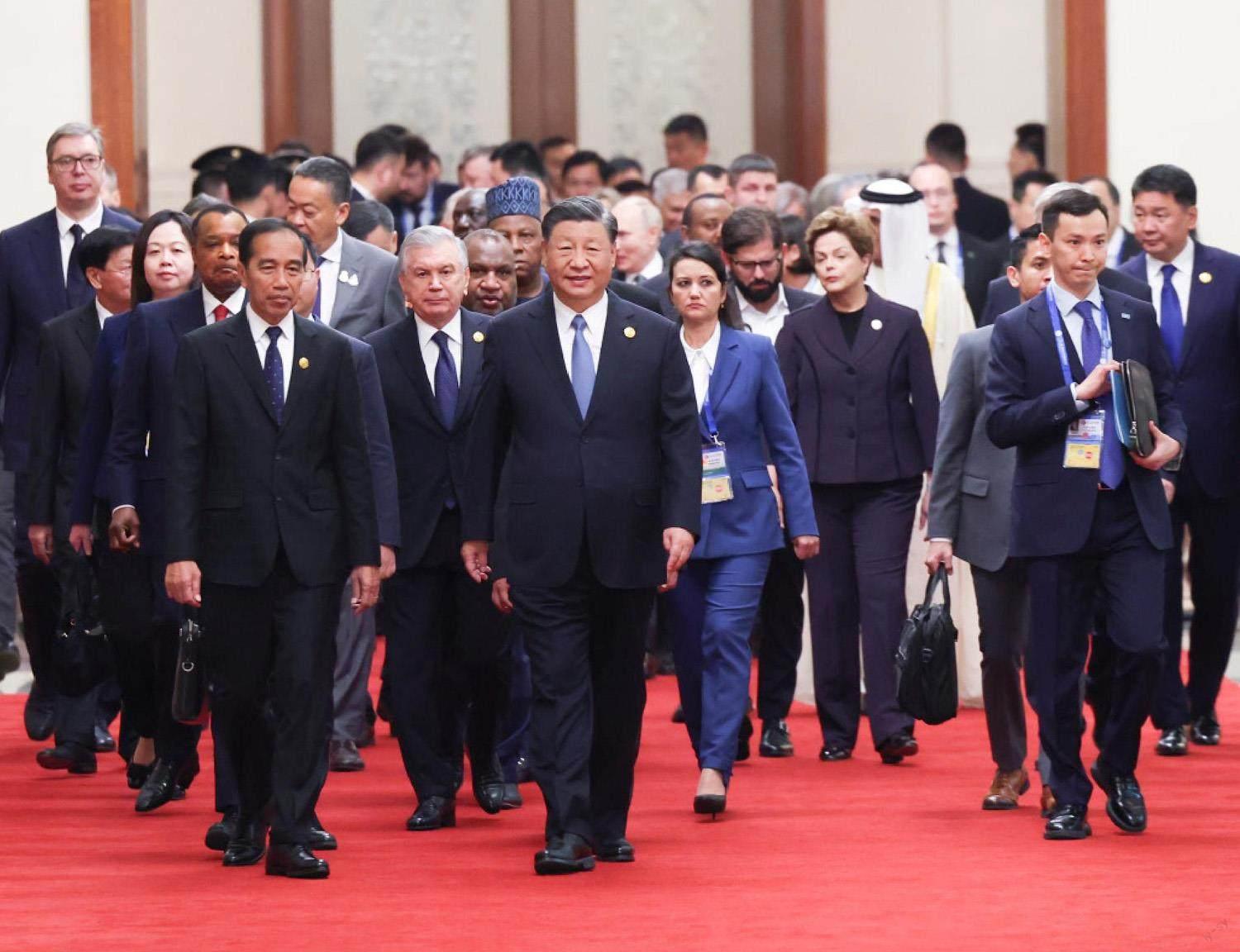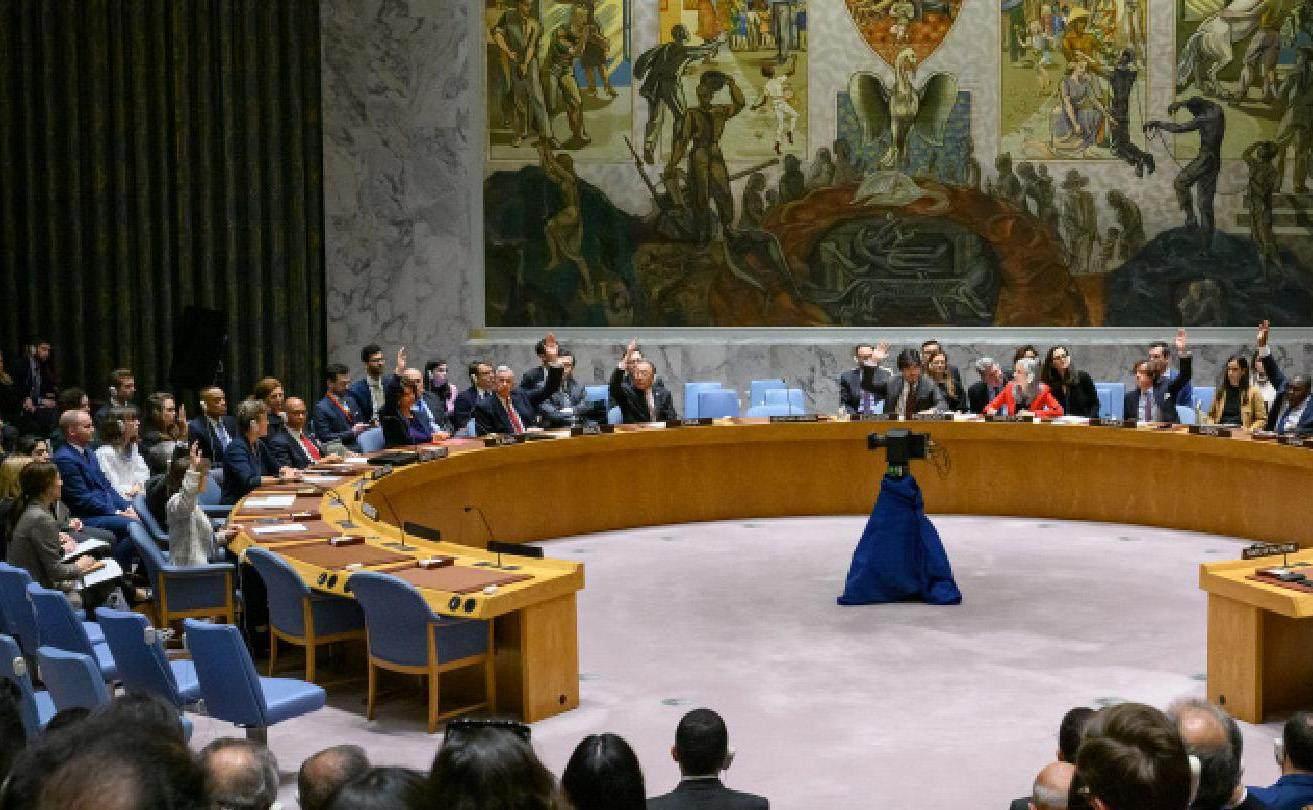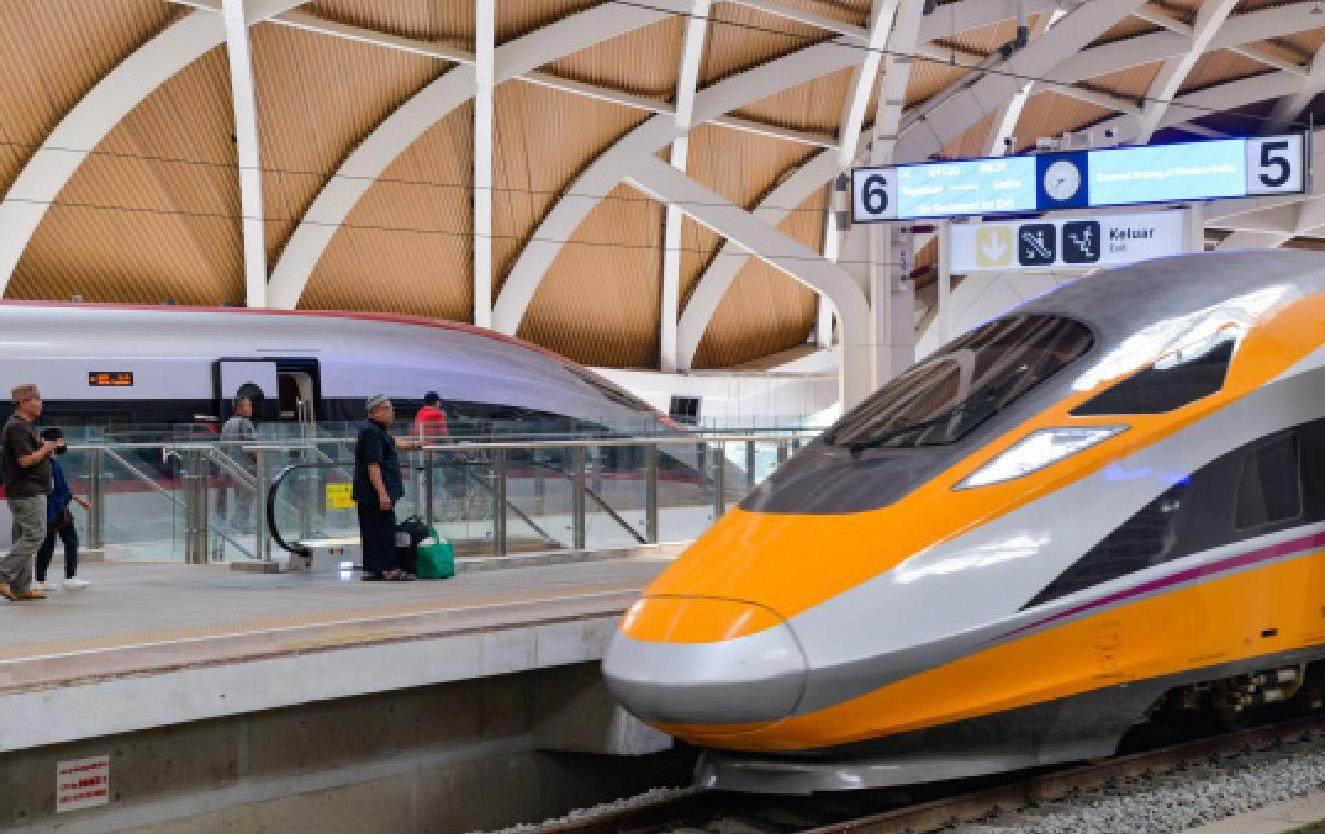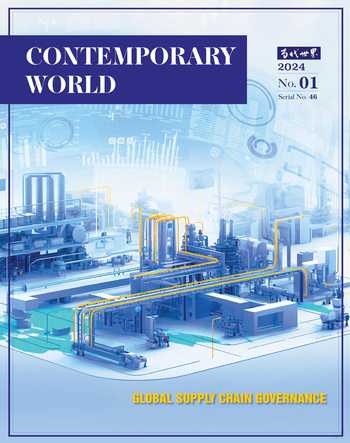A Guiding Beacon for a Perplexed World and A Lasting Power for Improving Quality and Growth
Wang Fan



The world today is entering a new period of turbulence and change, with frequent and overlapping crises. Confrontations in international politics are mainly concentrated in the three major geopolitical sectors. The international landscape is being fractured and reorganized, and some new features and trends are gradually emerging. The formation of “mini-multilateral” clubs has accelerated under the competitive situation, the possibility of a new Cold War in Europe has risen, the United States “friendly offshore outsourcing” and supply chain reorganization strategy has led to a trend of fragmentation in the global economy, and the Global South has risen and contributed to the reshaping of the geopolitical landscape. In the face of many uncertainties, risks and challenges in the world today, China has upheld the concept of building a community with a shared future for mankind, put forward innovative global governance programs, promoted major country diplomacy with Chinese characteristics, and created new opportunities and made new contributions to world peace, development and governance through its own development and progress.
The World Has Entered A New Period of Turbulence and Change
I. Crisis: Development and Security Issues Remain Prominent
The international situation in 2023 can be described as a crisis. The energy and food crises have been triggered by local war crisis, and the debt crisis has deepened as a result of the overlapping of multiple crises. The spillover effects of the crisis have been magnified as never before, and the energy, nuclear, food and debt crisis are intertwined, directly jeopardizing the environment and quality of human existence.
On the one hand, the deficit in global security governance has widened, and traditional and non-traditional security threats have become mutually reinforcing. The withdrawal of major powers from international treaties has raised the risk of nuclear proliferation, and the international arms control is facing multiple challenges. In February 2023, Russia announced the suspension of the New Strategic Arms Reduction Treaty (NSART); and in November, Russia and NATO announced the formal withdrawal from and suspension of the Treaty on Conventional Armed Forces in Europe (CFE). U.S.-British-Australian nuclear submarine cooperation exacerbates the risk of global nuclear proliferation and poses a serious impact on global security, especially in the Asia-Pacific region. Disruptive technologies in the fields of outer space, cyber space, biology and artificial intelligence are developing at a rapid pace and are being rapidly applied in international conflicts, and the international community has yet to reach an agreement on the norms governing the use of high and new technologies, so that international strategic stability is facing serious challenges.
On the other hand, under the current severe and complex situation, non-traditional security threats have to some extent been overshadowed by traditional security threats, and have not been fully emphasized by all countries. Global demographic problems are highlighted, and the employment pressure brought by labor force reduction and aging is increasing. International oil and gas prices continue to fluctuate in 2023, and the production capacity of a large number of energy-intensive industries in Europe has plummeted, so the energy crisis has had a worldwide impact. The World Health Organization reports that 675 million people worldwide still lack access to electricity, 2.3 billion people rely on hazardous fuels for cooking, and the world is far from achieving the 2030 Sustainable Development Goals. Global terrorist activities were concentrated in South Asia and sub-Saharan Africa, and terrorist organizations were linked to transnational organized crime groups. Some less developed regions also face a serious food security crisis.
II. Conflicts: Two Local Wars with Far-Reaching Consequences
The Ukraine crisis and the Israeli-Palestinian conflict are the two local wars with the highest intensity and most far-reaching impact in 2023. The Western countries have been increasing their assistance to Ukraine, squeezing Russias strategic living space, and launching a “cognitive war” aimed at competing for peoples hearts and minds and shaping peoples worldview. The U.S. uses artificial intelligence technology on the battlefield to anticipate Russian military actions, and while Russia and Ukraine frequently launch large-scale drone strikes. In September 2023, U.S. Assistant Secretary of Defense Marla Carlin noted that Ukraine has become a “l(fā)aboratory for military technological innovation,” and that technological innovations in the fields of artificial intelligence and drones have been used on the battlefield. The Western countries, led by the United States, continue to send advanced weapons and ammunition to Ukraine, including cluster munitions and depleted uranium munitions, which have caused endless harm. The Ukrainian crisis is characterized by a hybrid war: in addition to the use of high-tech and heavy weapons, the United States and other countries are also using financial sanctions and the Starlink system in the service of this proxy war.
The Israeli-Palestinian conflict is the biggest “black swan” event in the world in 2023. On October 7, 2023, Hamas launched a three-dimensional air, land and sea raid on Israels mainland called Al Aqsa Floods. More than 3,000 rockets were fired in less than 24 hours, breaking through Israels Iron Dome air defense and intelligence system. The Israeli army suffered the heaviest blow since the Yom Kippur War in 1973. Since then, the Israeli army has launched a large-scale retaliatory military operation against the Palestinians, and the death toll on both sides has exceeded 20,000 people. The likelihood of this conflict escalating into a sixth Middle East war is relatively small, and the possibility of it evolving into a prolonged, low-intensity localized war is higher. Regional hotspot issues have given rise to a highly sensitive period of transition in the international landscape, making coordination among the major countries even more difficult, and the situation in the region will be characterized by great volatility and even long-term turbulence.
III. Confrontation: Three Major Geopolitical Sectors Are Clearly Active
The current competition in international politics is mainly distributed among three major geopolitical plates in the Eurasian continent, namely, the conflict between Russia and NATO in the western part of the continent, the so-called Indo-Pacific alliance system in the eastern part of the continent to suppress China, as well as the confrontation between the Arab world and the U.S. and its regional proxies in the central part of the continent. The military confrontation with the United States and NATO under its leadership on the one side and Russia on the other side is heading towards a long-term strategic stalemate, with an unstable equilibrium between the two sides. The U.S. is focusing its strategic center of gravity on the Asia-Pacific region, attempting to escalate its vague strategy toward Taiwan region and supporting Japan and the Philippines in the East China Sea and the South China Sea, with a tendency toward camping, grouping, and NATOization in the Asia-Pacific region. U.S. favoritism toward Japan, the Philippines, the “Taiwan independence” forces, and India will further reduce Sino-U.S. strategic mutual trust, intensify the arms race in the Asia-Pacific region, and raise the risk of crisis. Israel, the U.S. ally in the Middle East, is embroiled in a new round of conflict with the Arab world, resulting in the U.S. being unable to concentrate its strategic resources in the short term.
The overlapping systems in the Asia-Pacific region have become the centralized manifestation of the competition in the regional security order. The so-called “multilateralization of the Asia-Pacific regional alliance” of the United States is aimed at setting up a separate gateway and engaging in a small circle, which has impacted on the Asia-Pacific security order and exacerbated the problem of overlapping regimes, which was already prominent in the Asia-Pacific security governance process. The overlapping of systems in the Asia-Pacific region means that there is a lack of a common collective identity, binding rules, expectations of stability and guidance for action among countries, which is not conducive to joint efforts to resolve regional security problems. The U.S. alliance system has continued to extend into the Asia-Pacific region, expanding into economic, security and other areas. The United States has incorporated many new areas into the design of its alliance system, such as supply chain security, artificial intelligence, semiconductors, cyberspace, clean energy, etc., in an attempt to consolidate its alliance system through its control of new areas.
Fission and Reorganization of the International Landscape
I. “Decoupling”: Accelerates Formation of “Mini-Multilateral” Clubs
Based on bilateral alliances, the United States has constructed an issue-oriented mini-multilateral mechanism. The Biden administration has pursued a strategy of “small yards and high fence” and selective decoupling in the field of high technology, in an attempt to construct a new globalization platform that does not benefit China. The United States in the field of high technology to actively encourage the head of the enterprise reflux to the United States, Europe and Japan; to encourage labor-intensive industries diversion to Southeast Asia, South Asia and other regions. Through the construction of “clean network” program in different industrial fields, “chip quadrilateral alliance” and other small clubs with the exclusion of China, the Chinese industry is to carry on with their joint blockade.
The United States actively promotes the return of the manufacturing industry and the reshaping of the international industrial chain and supply chain, and takes the lead in the formation of the “Friendship Industry and Technology Alliance”, so that the global industrial chain and supply chain is moving towards grouping, “friend-shoring” and “near-shoring”. The U.S. “friend-shoring outsourcing” focuses on six major supply chain areas, such as semiconductors, new energy, pharmaceutical manufacturing, strategic raw materials, communications equipment and infrastructure, and other cutting-edge technologies, and is characterized by a high degree of value bonding, zero-sum mindset-led policies, and focus on strategic industries, etc., with the essence of accelerating the de-coupling from China and weakening the Chinas influence in the global economy, and at the same time attempting to utilize “friend-shoring outsourcing” to safeguard its position in the global supply chain. If “friend-shoring outsourcing” continues, the global economic system will face the risk of fragmentation, and China will not only be threatened by the United States in terms of supply chain security, but may also face a more aggressive United States policy towards China. The United States will also take this opportunity to improve its alliance system and promote the weaponization of trade and supply chains.
II. Fission: Fragmentation and Supply Chain Reshaping
Economic globalization is experiencing serious impacts, and the waves of trade protectionism and anti-globalization are leading to economic fragmentation, with the original global production and supply chain, which worked well as a whole, being artificially torn apart. The fragmentation and meshing of the international market is threatening to break and reconfigure the entire chain of production and supply. The world economy is splitting into geopolitical blocs with different trade and technology standards, payment systems and reserve currencies, and the possibility of two parallel markets is increasing. Of course, these two parallel markets will not be clearly separated, but will cross and intersect in some countries and regions.
III. Confrontation: the Rising Possibility of a New Cold War in Europe
The Ukrainian crisis and Crimeas incorporation into Russia imply the finalization of a new regional system, or a “New Versailles System” and have defined the limits and boundaries of the eastward expansion of the New Versailles System. For Russia, the end of Crimea means that Russia has kept the bottom line, laying a solid foundation for Russias future revival; for Europe, it means that Europes eastward expansion has reached its limit. The possibility of a new Cold War in Europe has increased. First of all, the new Cold War is still the main manipulator of the United States and Russia, both sides to a certain extent have continued the policy thinking mode of the United States and the Soviet Union during the Cold War. Second, the United States and Europe hope to weaken Russia through economic sanctions and diplomatic isolation, forcing it to make concessions. Third, there has been a trend of increasing military deterrence between the two opposing sides. Fourth, the U.S., Europe and Russia are in a full-scale scramble for Ukraine while avoiding a direct military conflict and strictly preventing a hot war from occurring.
IV. Reorganization: The Rise of the Global South
The rise of the Global South countries and its strategic value have become an important force affecting the international pattern. The United States and the West have deliberately politicized and instrumentalized the concept of the Global South with the aim of weakening Chinas influence among the developing countries. The term Global South appears 55 times in the Munich Security Report 2023. Strengthening relations with the Global South was one of the main topics of the G7 Summit. Among the countries of the Global South, the middle powers are important forces contributing to the reshaping of the geopolitical landscape and the transformation of the world. There are a number of possible trends in the future of the world. One is that major countries coordination will give way to major countries dysfunction, with deepening global fragmentation and the re-emergence of two or more power blocs and complex confrontations. Another is that the world will accelerate its transition to a multipolar world, but the process of multipolarity may be hindered to a greater extent by hegemonic powers. More countries may opt for a more autonomous third path. Sub-powers or middle powers may take advantage of conflicts among the major powers to stand out. The pluralism and vacillation shown by middle powers at the policy level also exacerbate the instability of the international community to a certain extent.
Major Country Diplomacy with Chinese Characteristics Breaks New Ground
The world is in the midst of fierce competition, and mankind is faced with the choices of mutually beneficial and win-win situations versus closed and conservative ones, democratization of international relations versus power politics, and economic globalization versus “de-risking” development paths. In the face of many uncertainties and challenges in the world, China has actively promoted high-level opening up to the outside world and the unity, connectivity and solidarity of the international community, adhered to the concept of building a community with a shared future for mankind, deepened its cooperation with the vast number of developing countries, and put forward a series of innovative proposals for global governance, thus becoming an engine of global sustainable development, a bounding force for common development, and an explorer of a new type of modernization.
I. Leading: Head-of-State Diplomacy Leads the Way, and Host Diplomacy Has Achieved Remarkable Results
Head-of-state diplomacy highlights the efforts and commitment of leaders of major countries to bring stability and positive energy to a turbulent world. From August 21 to 24, 2023, President Xi Jinping attended the 15th meeting of BRICS leaders and paid a state visit to South Africa. The Chinese and Iranian heads of state met in Beijing in February 2023, laying the political foundation for Saudi-Iranian rapprochement. And on April 6, the Saudi foreign minister and the Iranian foreign minister signed a joint statement in Beijing announcing the official restoration of diplomatic relations between the two countries. Chinas head-of-state diplomacy contributed to the historic reconciliation in the Middle East. On December 12 to 13, Xi Jinping, General Secretary of the CPC Central Committee and President of the Peoples Republic of China, paid a state visit to Vietnam, and together with Nguyen Phu Trong, General Secretary of the CPV Central Committee, declared the building of a Sino-Vietnamese community with a shared future, which opens a fresh chapter in Sino-Vietnamese relations in the new era. From the first China-Central Asia Summit to the third Belt and Road Forum for International Cooperation, and from the BRICS leaders meeting in Johannesburg to the APEC Leaders Informal Meeting in San Francisco, the head-of-state diplomacy reflects Chinas mission as a responsible major country.
The China-Central Asia Summit held in Xian in May 2023 was the first time that the heads of state of China and six Central Asian countries organized a summit in physical form, deciding to establish a mechanism for China-Central Asia heads of state to meet and join hands to build a closer China-Central Asia community with a shared future. In June, the 14th Summer Davos Forum was held in Tianjin, exploring ways for economic recovery and sustainable development, and becoming an important platform for solving global development problems and providing Chinese solutions. The 3rd Belt and Road Summit on International Cooperation in Beijing in October was Chinas most important main diplomatic event in 2023, with a total of 458 achievements, opening up the way for high-quality cooperation for the Belt and Road construction.
II. Universal Benefits: The Concept of Amity, Sincerity, Mutual Benefit and Inclusiveness Has Taken Root, and Neighboring Diplomacy Has Opened Up New Horizons
The neighboring countries are at the forefront of Chinas overall diplomacy situation. Since President Xi Jinping put forward the principle of amity, sincerity, mutual benefit and inclusiveness guiding Chinas neighborhood diplomacy in 2013, China has established a wide range of strategic cooperative partnerships with neighboring countries in the past ten years, and has made solid progress in building communities with shared futures with ASEAN, Central Asia, and the 5 Lancang Mekong countries. On December 25, 2023, the Fourth Leaders Meeting of Lancang-Mekong Cooperation was held and issued the “Declaration of Naypyidaw on the Fourth Leaders Meeting of Lancang-Mekong Cooperation”, the “Five-Year Plan of Action of Lancang-Mekong Cooperation (2023-2027)”, and the “Joint Initiative on Construction of Innovation Corridors in Lancang-Mekong”. Guided by the principle of amity, sincerity, mutual benefit and inclusiveness, Chinas relations with its neighboring countries have been steadily moving forward, and China-ASEAN relations, in particular, have become the most successful and vibrant model of Asia-Pacific regional cooperation, and a vivid example of the promotion of building a community with a shared future for mankind.
III. Growth Rate: Belt and Road Advances Solidly, Boosting Quality and Speed for the World Economy
The year 2023 marked the 10th anniversary of Belt and Road Initiative. China successfully hosted the third Belt and Road Summit Forum for International Cooperation. As of 2023, China has signed more than 200 documents on Belt and Road cooperation with 152 countries and 32 international organizations, covering 83% of the countries with which it has established diplomatic relations, spreading across five continents and major international organizations, and building a wide circle of friends. According to a study by the World Bank, by 2030, the Belt and Road Initiative is expected to generate an annual benefit of 1.6 trillion U.S. dollars for the world, accounting for 1.3% of the global GDP, 90% of which will be shared by partner countries. Building the Belt and Road together will lift 7.6 million people out of extreme poverty and 32 million people out of moderate poverty, injecting a strong impetus to world economic growth and providing a viable solution for improving global governance. The Belt and Road Initiative is deepening and expanding in all aspects, reshaping the worlds geo-economic map, enhancing global connectivity, driving the integration of the digital economy, green and low-carbon and cutting-edge high technology, adding more certainty to the international situation.
IV. Stabilization: U.S.-China Relations Turn Around, Ushering in A Phased Relaxation
In November 2023, President Xi Jinping was invited to San Francisco, U.S., to hold a heads of states meeting with President Biden, and to attend the 30th Informal APEC Leaders Meeting. President Xi Jinping pointed out that China and the United States should work together to establish correct perceptions, work together to effectively manage differences, work together to promote mutually beneficial cooperation, work together to shoulder the responsibilities of a major country, and work together to promote humanistic exchanges. President Xi Jinpings words have built five pillars for the stable development of China-U.S. relations and opened up a new vision for the future of China-U.S. relations. “The road to San Francisco” will not be a smooth one, and we cannot rely on “auto-pilot”. The meeting of the heads of states is of great historical significance and far-reaching practical significance, forming a future-oriented San Francisco Vision, which points out the direction for realizing the healthy, stable and sustainable development of China-U.S. relations.
V. Expansion: BRICS Mechanism Adds Bricks, Ushering in Strong Membership Increase
Since the establishment of the BRICS Cooperation Mechanism, the foundation of cooperation has been strengthened and the scope of cooperation has been expanded gradually. Five years ago, President Xi Jinping initiated the BRICS+ model of cooperation, emphasizing the need to carry forward the BRICS spirit of openness, inclusiveness, cooperation and win-win situation, which has been actively supported and warmly responded to by all parties. In August 2023, the leaders of the BRICS countries decided at their meeting in Johannesburg, South Africa, to invite Saudi Arabia, Egypt and other countries to join the BRICS cooperation mechanism. At present, more than 20 countries have applied to join the BRICS cooperation mechanism.
The international situation is characterized by a mixture of turmoil and chaos, and the persistent problems of governance, development and trust deficits remain serious, while the international community is calling for the construction of a fairer and more reasonable international order. Under the turbulent international situation, China has become a beacon of guidance for the bewildered world and an enduring driving force for quality and growth. The innovative practice of Chinese-style modernization will continue to be a strategic opportunity for the development of all countries in the world. Major country diplomacy with Chinese characteristics is advancing on all fronts, contributing Chinese wisdom and Chinese solutions to global governance, injecting certainty and enhancing stability into the international chaos, and with the mission and bearing of a responsible major country, becoming an important carrier of the new form of human civilization and an important driving force for building a community with a shared future for mankind.
——————————————
Wang Fan is President of China Foreign Affairs University
- 當(dāng)代世界英文版的其它文章
- International Supply Chain Cooperation and China’s Role
- Analysis and Prospects of the World Economic Situation 2023-2024
- The International Security Situation in 2023: Seeking Order Change and Reshaping Amidst Turbulence and Uncertainty
- The Cultural Gene and Historical Experience of China’s Peaceful Development
- Developments in the U.S. Republican Party Since the 2020 Election
- The Rise and Impacts of Kenya’s Hustler Movement

